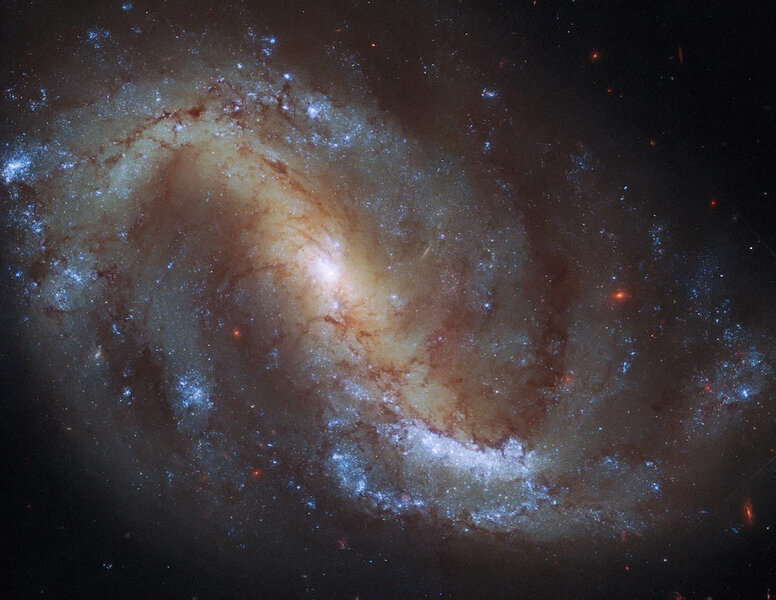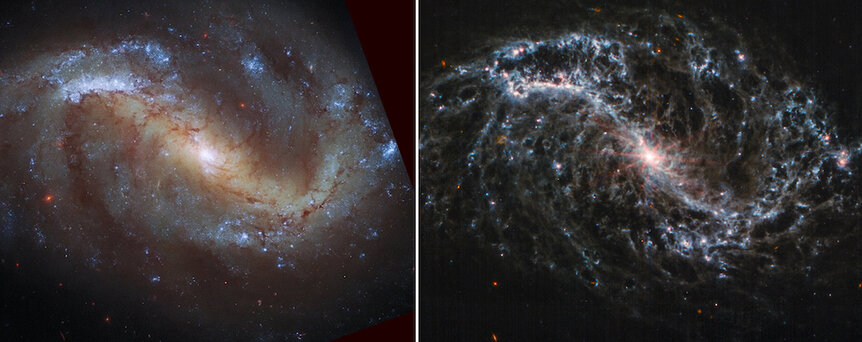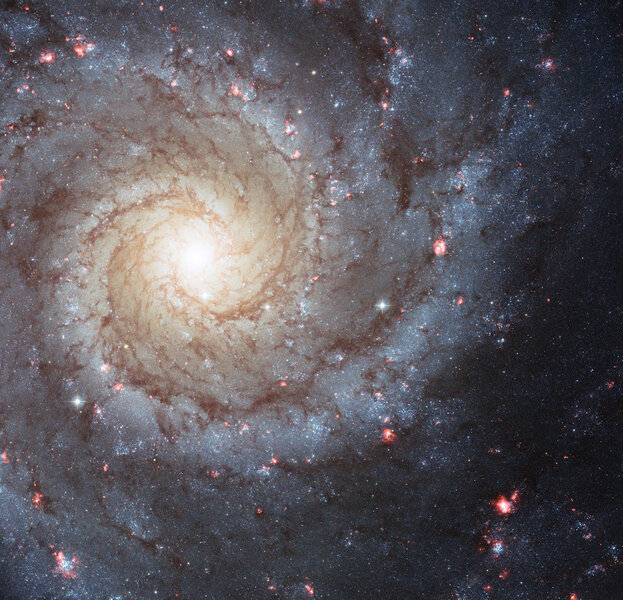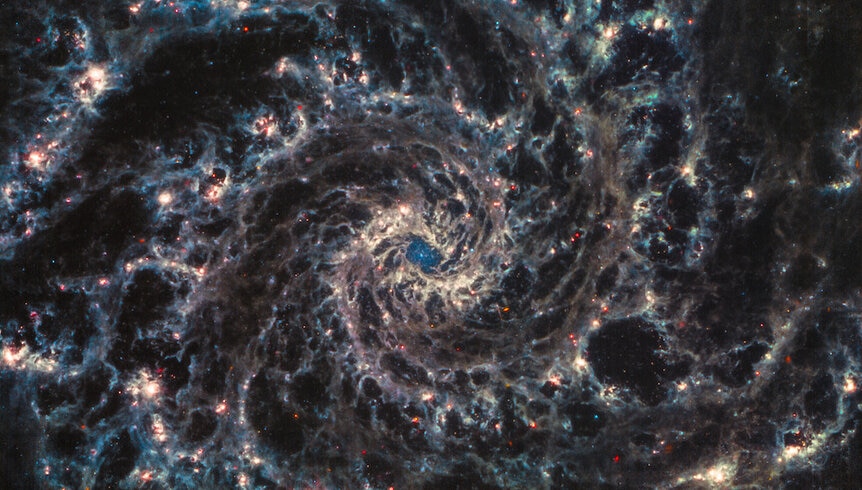Create a free profile to get unlimited access to exclusive videos, sweepstakes, and more!
The spooky swirly spiral galaxies of JWST
Dust comes alive when JWST views spiral galaxies.
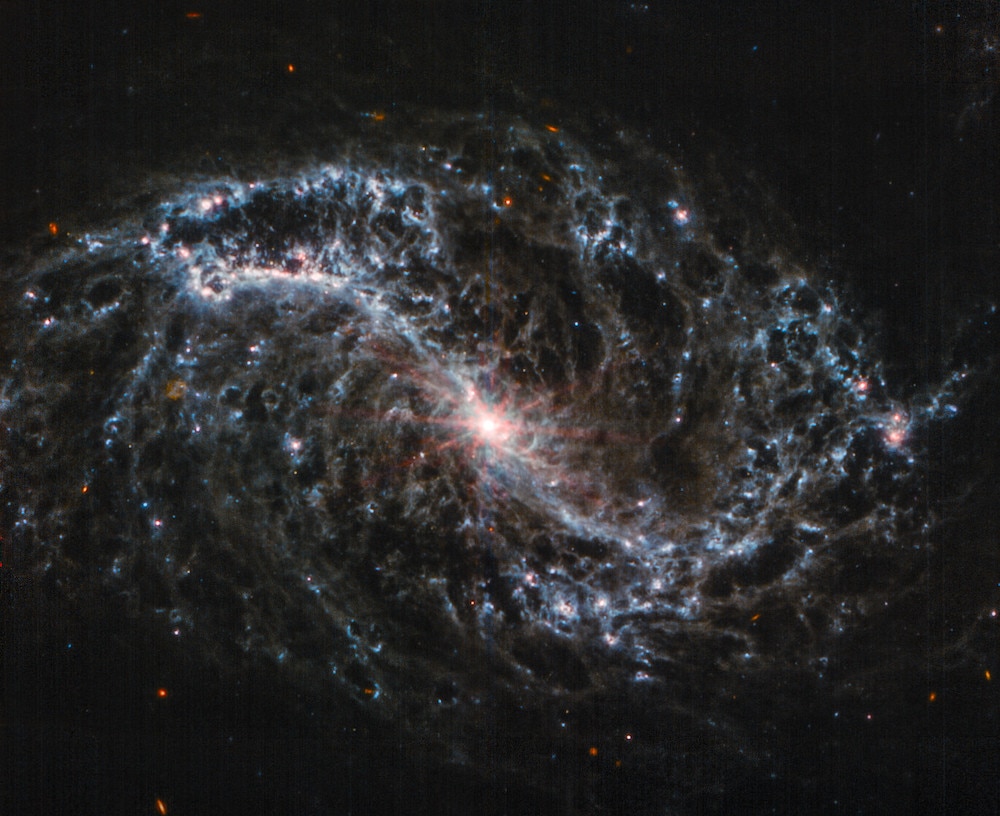
Astronomers — and the public — are still reeling from the first images released taken by JWST. In many ways they’re similar to Hubble images, with amazing clarity and beauty.
But in a fundamental way they are very different. Hubble can see ultraviolet light, visible light — the kind we see — and a little bit into the infrared, where light has wavelengths longer than about 0.75 microns, the reddest red we can see.
JWST, however, is designed to see in the infrared, with only a little bit of overlap into visible light. Its NIRCAM instrument can detect light from about 0.6 microns out to 5 microns, and MIRI takes over from there, seeing light from 5 out to 30 microns.
When you see these wavelengths, the Universe looks very different. Very. One of the coolest (so to speak) examples of this is dust: tiny grains of material made from rocky/metallic molecules or long-chain carbon molecules that are essentially soot. This stuff is made when stars die, blown out into interstellar space where they collide and merge and form long streaming filaments in spiral galaxies that follow the overall spiral pattern.
In visible light thick dust is opaque, blocking the light of stars behind it, so we see dust clouds as dark. But this dust is warmed by starlight, and glows in the infrared.
For example, here is Hubble’s view of the gorgeous spiral galaxy NGC 7496, relatively close by at 24 million light-years from Earth:
Stars are the most obvious things in this image, which spans ultraviolet to near-infrared. Places where stars are being born look blue; massive, luminous stars are blue, and don’t live very long, so they trace the locations of stellar nurseries along the spiral arms. Dust appears dark, silhouetted against the background stars. Dust lanes also trace the spiral arms, since massive stars generate vast amounts of dust when they die.
But now look what happens when we switch to JWST’s infrared view.
Whoa. Stars don’t produce nearly as much infrared light as dust does, so there are essentially none of NGC 7496’s stars visible here. Instead the dust lanes glow, their warm light easily seen by JWST. The compact star-like objects you see are likely giant clouds of dust and cold gas called molecular clouds. These are usually locations where thousands of stars are being born.
To make it easier to compare them, I rotated and cropped the Hubble image to match the JWST one:
Now you can see where the dark dust lanes in visible light come alive in infrared. Look to the upper left in the Hubble shot where there’s a vast elongated star-forming area; in the JWST view that can also be seen to be choked with dust. Direct comparisons like this will help astronomers learn where and how stars are born on huge scales in galaxies, while the incredible resolution of both telescopes will allow them to zoom in on individual nurseries to better understand their properties.
I’ll note that in the core of NGC 7496 is a supermassive black hole that’s actively gobbling down matter. This material heats up as it falls in and glows brightly in infrared — sometimes too there is a huge donut-shaped torus of dust around the black hole which can block a lot of that light in visible wavelengths. This is hard to see in the Hubble image, but the brilliant star-like core is so much more luminous in infrared it actually has diffraction spikes — the cross-hair-like structures — an optical effect generated in telescopes by bright, unresolved sources. So bonus: We get to learn about NGC 7496’s black hole with JWST imaging as well.
Here’s another fantastic example: The spiral galaxy M74, which is about 30 million light-years from us. Hubble first:
Again, a grand design spiral with arms flung out. The filters used in this case also emphasize star-forming clouds of hydrogen that glow pinkish-red, huge nebulae that put our own Orion Nebula to shame.
But the view becomes quite different and significantly eerier with JWST:
Wow! The dark dust suddenly is much easier to see, while the stars are gone, and even the giant gas clouds subdued. The interconnecting clouds of dust look like a skeleton, a framework on which the galaxy hangs.
The huge hole on the lower right is interesting. If lots of stars are born in one place their combined winds of particles — similar to the Sun’s solar wind but far more powerful — can carve out a cavity in the gas and dust, making a hole. Exploding stars can help with this as well. The material is compressed along the edge of the cavity, increasing star formation there, and you can see several bright clumps of material where new stars are being forged. This is practically invisible in the Hubble image; I couldn’t find any hint of it (note the Hubble image is rotated by about 45° counterclockwise relative to the JWST image). That same hole can be seen in Spitzer Space Telescope infrared images as well, though it was a much smaller telescope so the image isn’t as sharp.
Look to the center, too: Right at the galaxy’s heart the dust seems to clear out, leaving a bluish glow. Look more carefully and you can see it’s clumpy, and those dots may be stars or clusters of stars forming in the galactic center, their winds blowing the dust away and allowing us to peer deeply inside.
The whole point here is that with the high-resolution and deep infrared views of JWST we see galaxies in quite literally a different light, and that leads to insights on their behavior in ways we cannot get with just visible light. This is why we build telescopes sensitive to different parts of the spectrum! We see the results of different physics, and that gives us a more complete picture of what’s going on. The more pieces of this incredibly complex cosmic puzzle we have the better off we are.
